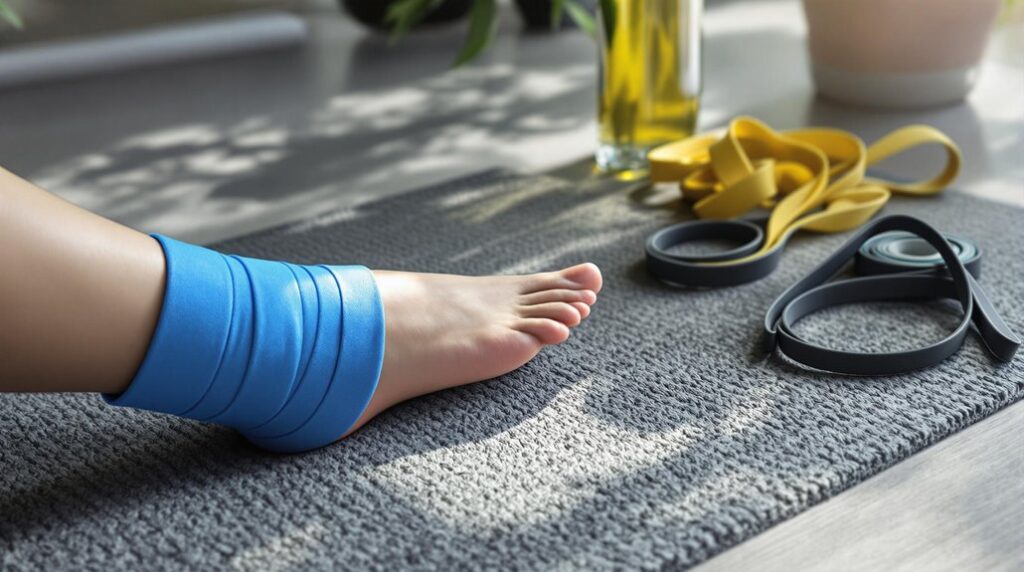To effectively rehabilitate a sprained ankle, begin with the RICE method—Rest, Ice, Compression, Elevation. Focus on pain relief, as it's essential for mobility and successful recovery. Incorporate important exercises, like ankle circles and heel raises, to restore strength and flexibility. Progress gradually, monitoring pain levels and increasing activity as advised. Regular consultation with a healthcare professional will provide tailored guidance. Continue to explore critical rehabilitation strategies for best recovery results.
Understanding Ankle Injuries
Ankle injuries, particularly sprains, represent a vital concern for athletes and active individuals alike. These injuries account for approximately 20-25% of all athletic injuries, with the lateral ligament complex being the most frequently affected. The severity of ankle sprains is classified into three grades: Grade I involves a mild stretch of ligaments, Grade II indicates a partial tear, and Grade III signifies a complete tear. If not properly rehabilitated, ankle sprains can lead to long-term instability, with studies showing that up to 70% of individuals may suffer recurrent sprains without adequate treatment. Early intervention is essential, as a structured rehabilitation program can greatly reduce recovery time, allowing many individuals to return to their pre-injury activity levels within 4 to 6 weeks for Grade I and II sprains.
Initial Management and RICE Method
After experiencing a sprained ankle, immediate management plays an essential role in guaranteeing a smooth recovery. The RICE method—Rest, Ice, Compression, and Elevation—is vital. Start by resting your ankle; avoid putting weight on it, and consider crutches to prevent further injury. Applying ice wrapped in a cloth for 15-20 minutes every 1-2 hours during the first 48 hours can greatly reduce swelling and numb pain. Next, use an elastic bandage for compression, which offers support and helps control swelling; just make sure it's not too tight to restrict blood flow. Finally, elevate your ankle above heart level as much as possible to facilitate fluid drainage and further diminish swelling. Following these steps is essential for effective recovery.
Importance of Pain Relief
Effective pain relief is essential for a successful rehabilitation process following a sprained ankle, as unmanaged pain can severely limit your mobility and hinder participation in important exercises. Adequate pain management enhances your ability to engage in rehabilitation activities, ultimately leading to improved outcomes and quicker recovery times. If you're experiencing severe pain, it's wise to consult with a pharmacist or GP, who can recommend tailored pain management strategies. Regularly monitoring and documenting your pain levels allows healthcare providers to adjust your pain relief measures effectively. Exploring various options, including medications and physical therapies, guarantees thorough management of pain during recovery, which is critical for regaining strength and function in your ankle.
Essential Ankle Exercises
In order to facilitate a successful recovery from a sprained ankle, incorporating essential ankle exercises into your rehabilitation routine is crucial. Start with ankle circles, rotating your ankle in full circles, both clockwise and counterclockwise, to improve mobility. Next, perform ankle pumps by briskly bending and straightening the ankle, which enhances circulation and reduces swelling. A deep calf stretch is also important; stand with one foot in front, bending your knees to stretch the back leg's calf muscle. Additionally, execute heel raises by standing and pushing up onto your toes, which strengthens calf muscles and improves balance. Consistent practice of these exercises can greatly aid in your recovery, restoring strength, flexibility, and range of motion.
Gradual Progression in Rehabilitation
As you commence your rehabilitation journey following a sprained ankle, recognizing the importance of gradual progression is key to achieving the best recovery. Start with gentle range-of-motion exercises, like ankle circles and pumps, as these help maintain flexibility. Once you feel comfortable, shift to more challenging movements, such as heel raises. It's essential to increase the intensity of your exercises based on your comfort levels, moving from non-weight-bearing to weight-bearing activities as advised. Pay attention to your pain levels; they'll guide you in advancing your exercises without risking reinjury. Regularly consulting with a physiotherapist can provide tailored guidance, ensuring your rehabilitation program meets your specific recovery needs and adjusts based on your progress.
Communicating With Your Healthcare Provider
How can you guarantee that your recovery from a sprained ankle is as smooth and effective as possible? Regularly updating your healthcare provider about your pain levels and any changes in your condition is essential for effective management of your recovery plan. Document any difficulties you face during rehabilitation exercises, as this information helps your provider tailor your treatment. Communicate openly about concerns or questions to foster a collaborative relationship with your healthcare team. Schedule follow-up appointments to discuss your progress and adjust your exercises based on your unique recovery experience. Utilize available resources, like physiotherapists or pain management specialists, and inform your healthcare provider if you need additional support to optimize your rehabilitation journey.


